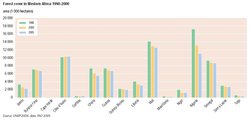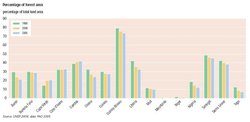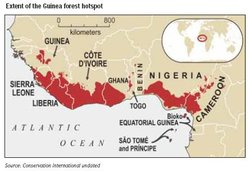Western Africa and forests and woodlands
Contents
Inventory of resources
The total forest cover in Western African is about 115 million hectares (ha), representing 12 percent of the total land area (FAO 2005). Forest cover varies considerably from one country to another, as shown in Figure 1. Guinea-Bissau is the most forested with 60.5 percent forest cover, while Mauritania is the least forested with only 0.3 percent.
The Guinea Forest of Western Africa, which extends from the coastline of Guinea to the borders of Cameroon, is important from a biodiversity perspective. It is recognized by Conservation International as one of the world’s biodiversity hotspots and encompasses part of the Upper Guinea Forest Ecosystem, which covers parts of Guinea, eastern Sierra Leone, Liberia, Côte d’Ivoire, Ghana and western Togo. It also encompasses the Lower Guinea Forest Ecosystem, including western Nigeria, south-western Cameroon, the islands of Bioko and Pagalu (Equatorial Guinea), as well as São Tomé and Príncipe. The extent of this area is shown in Figure 3. The area is under considerable pressure from logging industries and farming or hunting activities. Only 15 percent of its original vegetation (approximately 141,000 km2 of closed canopy forest cover) is left, and is, moreover, highly fragmented. The largest remaining portion is in Liberia, where civil conflicts have disrupted conservation activities.
Deforestation varies across the region. In terms of land area, Nigeria and Côte d’Ivoire have by far the highest annual rate of forest loss, at nearly 663,000 ha.
Statistical data on forest plantations is unreliable due to lack of inventory and frequent forest fires, lack of maintenance, and uncontrolled land clearance for cultivation. However, countries like Côte d’Ivoire, Benin and Nigeria have made some efforts in the establishment of industrial plantations. In the Sahelian zone, such plantations are not established on an industrial basis and are less important, except in Senegal where plantations are created to stop desertification, which is a pressing ecological problem.
Endowments and opportunities
In several countries, especially in the Sahel, more than 90 percent of wood consumed is used as fuelwood, mostly for domestic energy requirements. For example, in Mali and Burkina Faso 93 and 96 percent, respectively, of wood is used for fuel. In Gambia, 97.8 percent of all household energy comes from wood energy. Nigeria and Côte d’Ivoire are the leading roundwood producers in the sub-region. For example, roundwood production in 2000 in Côte d’Ivoire amounted to about 3.4 million m3 and in Nigeria to 9.4 million m3. The timber industry represents an important source of gross national product (GNP).
Western Africa’s forests present a good potential for carbon sequestration. With the clean development mechanism (CDM), a monetary value can be given to environmental benefits coming from activities aimed at reducing carbon emissions.
Challenges faced in realizing opportunities for development
 12 year-old ULIMO fighter in the forest, Monrovia (Source: D.Browne/ILO)
12 year-old ULIMO fighter in the forest, Monrovia (Source: D.Browne/ILO) Forest resources are threatened by a combination of factors, including agricultural expansion, increased collection of fuelwood, overgrazing, fast urbanization, industrialization, drought, civil wars and bush fires, which result in changes in forest cover. Rapid deforestation is an issue of major concern, given the scope of degradation, which started in the 1970s. According to FAO (2001), close to 12 million ha of forests were lost in Western Africa from 1990 to 2000. The other concern is rapid loss of unique flora and fauna. As the forests disappear, the populations of wild animals and plants also reduce.
Recurrent civil strife has had considerable impact on the forest resources. In Liberia and Sierra Leone, for example, timber was illegally exploited during the civil conflict to finance the war, resulting in the reduction of the two countries’ forest cover from 38.1 percent to 31.3 percent during the 1990s. In addition, after the war, reconstruction efforts further pressured forest resources through the increased demand for construction timber.
In the Sahelian zone, deforestation is spiralling out of control largely as a result of the vagaries of the weather. The challenges associated with climate change are discussed more fully Atmospheric resources in Africa. The rate of woody biomass offtake outstrips the natural regeneration to the extent that wood is not really considered a renewable resource any more. For instance, the annual rate of forest loss in Niger, which has the highest rate of deforestation, is about 100,000 ha against 5,000 ha of forest replanting.
Further reading
- AGRHYMET, 2002. Développement d’un cadre institutionnel et d’un réseau de données pour une gestion intégrée et l’élaboration de rapports sur l’état de l’environnement en Afrique de l’ouest, Rapport sur les pays du Sahel, Projet PNUE/REDDA. Centre Régional de Formation et d’Application en Agrométéorologie et Hydrologie Opérationnelle, Niamey
- FAO, 2002. Global Forest Resources Assessment 2000 – Main Report. FAO Forestry Paper No.140. Food and Agriculture Organization of the United Nations, Rome.
- FAO, 2003. Forestry Outlook Study for Africa African Development Bank, European Commission and the Food and Agriculture Organization of the United Nations, Rome.
- FAO, 2005. Food and Agriculture Organization of the United Nations, Rome.
- CEPF, 2000. Ecosystem Profile: Upper Guinean Forest, Guinean Forests of West Africa. Critical Ecosystem Partnership Fund.
- CNEDD-Niger, 2002. Développement d’un cadre institutionnel et d’un réseau de données pour une gestion intégrée et l’élaboration de rapports sur l’état de l’environnement en Afrique de l’Ouest, Projet PNUE/REDDA, CNEDD, Contribution nationale. National Environmental Council for Sustainable Development, Niamey.
- NEA, 2002. Development of a Collaborative Institutional Data Framework for Integrated Environmental Assessment and Reporting for West Africa. United Nations Environment Programme and Network for Environment and Sustainable Development in Africa project. National Environment Agency (NEA), Banjul.
- UNEP, 2004. Africa Environment Outlook: Case Studies – Human Vulnerability to Environmental Change. United Nations Environment Programme, Nairobi.
- UNEP, 2006. Africa Environment Outlook 2
- UNEP and NESDA, 2004. Rapport sur l’Etat de l’Environnement en Afrique de l’Ouest. United Nations Environment Programme and Network for Environment and Sustainable Development in Africa, Nairobi.
|
|
| Disclaimer: This article is taken wholly from, or contains information that was originally published by, the United Nations Environment Programme. Topic editors and authors for the Encyclopedia of Earth may have edited its content or added new information. The use of information from the United Nations Environment Programme should not be construed as support for or endorsement by that organization for any new information added by EoE personnel, or for any editing of the original content. |


